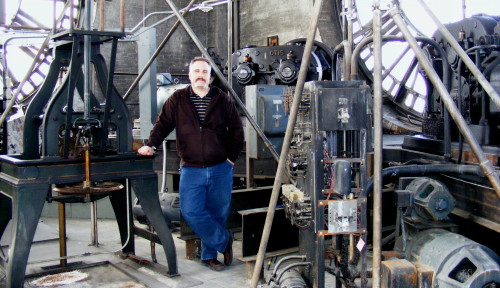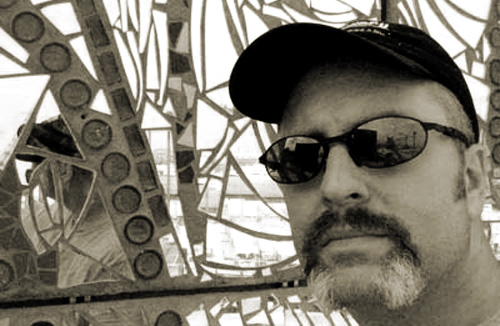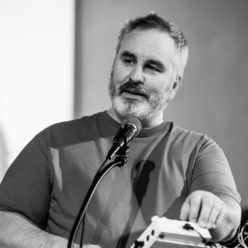
Joe Belknap Wall grew up in semi-rural Scaggsville, Maryland, caught in the half-light between Baltimore and Washington, D.C., and was raised in an environment of omnipresent storytelling. With family from Baltimore and Georgia, he had ample opportunity to absorb the rhythms and cadences of a good tale well told, and, after having been given a used typewriter by his often-exasperated mother, unsuccessfully attempted to write a novel at the age of twelve.
Television was a controlled substance in the Wall household, so Joe took refuge in radio, particularly in the unique mix of vintage and contemporary radio drama and experimental radio that was available to him before the medium dissolved in a wash of corporate monotony. Each night, he went to bed listening to the likes of The Jack Benny Program, Lights Out, and The Fourth Tower of Inverness and more, amazed by the potential of sound and voice that could be found in the work of people like Ken Nordine and the NPR’s Earplay and NPR Playhouse.
When he was old enough to get his hands on his first tape recorder, he started recording, and soon was cutting and splicing and making strange landscapes out of found sound. He refined his technique over the years, branching out into modular synthesis and modern digital sampling, always working on a balance between telling stories with words and building pictures out of pure sound, with lots of crossover as words were broken down into noises and cut and diced and recontextualized into new forms.
In the eighties, Joe began to experiment with form and context with his R-A-M-P project, a series of location-based performances that included an illegal satellite uplink and an ill-advised attempt to actually ring the Liberty Bell in a musical context, but he started to find a more coherent focus in 1991, when he began to write the sprawling script of a one-man show, This Nonstop March Around the World. When the actual performance time passed fourteen hours and the topics of the script had drifted far afield of his original concept, he reluctantly conceded that the project was out of control and technically impossible to present without substantial funding and a herd of expensive theater techs.
Taking the failure as an opportunity, Joe used the skills and techniques he’d gained in the meticulous construction of This Nonstop March… and went on to concentrate on smaller, self-contained performances, emerging with a minimalist exploration of dream life, titled “A Troubled Sleep,” which he performed to popular acclaim at Loyola’s McManus Theater in 1996. A wacky, but loving, tribute to his grandmother, “Easy Listening in Baltimore,” followed a year later at Slayton House in Columbia, MD, and he performed “This Nonstop March,” a small-scale exploration of the themes present in the now-abandoned piece, at Baltimore’s First Unitarian Church in 1998.
In 1998, Joe began a long relationship with the American Visionary Art Museum in Baltimore, brought into the fold by his long-time friend and mentor, Lorraine Whittlesey, and has since developed a series of annual performance pieces in association with the museum, integrating sound design, music composition, and storytelling with wild costumery and street theater in a series of evolving characters much-loved by patrons of the museum.
Joe started writing an online journal in 2001, taking the outlet presented by a new medium to return to his love of writing, and honed his skills, eventually writing pieces for Radar Review magazine and an essay for the Link arts journal that brought him an award from Baltimore Magazine for the best arts essay of 2001 in their “Best of Baltimore” annual edition. Since then, he’s performed a number of pieces, from “The Laser Farm Monologues” to “The Trampoline Spectator,” at venues around the Maryland region, culminating in his first full-length narrative performance, My Fairy Godmothers Smoke Too Much, which debuted in 2005 at the Creative Alliance’s Patterson Theater, in Baltimore.
Joe lives in Catonsville, Maryland, with his family, dogs, piles of sound-making machinery, stacks of books, and a haphazard collection of manual typewriters, and is currently editing a book of essays, entitled Scaggsville, and working on the first in a trilogy of pulp novels about the fringes of American culture, 9/11, astral-projection as an anti-depressant, and Dolly Parton, tentatively dubbed Dreamland Motel (and Ashram). He recently performed a live electronic soundtrack to the 1914 silent film His Majesty, The Scarecrow of OZ at the Patterson Theater, and is making detailed notes and sound studies for another full-length one-man show, The Corrugated Diva.
Having worked in the grim world of office work for far too long, Joe escaped the cubicle realm in 2004, taking up a new career as a journeyman carpenter, remodeling contractor, freelance writer, web designer, and general purpose jack-of-all-trades before being hired full-time by the American Visionary Art Museum. At AVAM, he worked as construction engineer and general purpose jack-of-all-trades for the second phase of the museum’s mosaic wall project, which is gradually covering the bare concrete walls of the building with a mosaic of mirror, broken pottery, bottles, and other ephemeral items found around town. Following that project, he was hired on as AVAM’s facilities director, overseeing the repair and maintenance of the three buildings of the museum, as well as technical projects for the museum ranging from exhibition installation to AV, events, and landscape design.
In 2009, Joe took a new position managing a pair of art facilities in Baltimore which provide studio, gallery, and classroom space for local artists. Over a period of four years, he managed Baltimore’s historic Bromo Seltzer Arts Tower, an adaptive reuse project converting a century-old twenty-two story clock tower built in the style of the Palazzo Del Vecchio to advertise a tranquilizer-laden hangover cure into a showplace of artist studios. In his time at the clocktower, he introduced interpretive history tours of the original machine room for the clock (which he maintained himself), created a dedicated theater space for drama, film, and readings, expanded gallery spaces, oversaw major repairs to the clock and tower, and worked with visual artists to turn the tower into a giant artwork visible throughout downtown Baltimore, all while doing all the administrative work for the tower and increasing studio rentals from forty to seventy percent occupancy.
At the same time, he served as the facility manager of the School 33 Art Center, a historic school in Baltimore’s Federal Hill neighborhood, maintaining the facility, overseeing rentals and mechanical issues, landscaped the outdoor areas, handled all relations with studio artists, supervised the installation of an elevator, making the then 122-year-old structure fully ADA-compliant, and worked with Blue Water Baltimore to plan a green reenvisioning of the landscaping on the South side of the building.
In 2013, having achieved his goals in Baltimore, Joe moved on and resumed a career of high-end carpentry and art education work before taking a position managing a community theater in Prince George’s County in 2014 and returning to his first loves of writing and working as a performing artist. Since 2017, he’s been on the faculty at the University of Maryland, working for the Center for Advanced Transportation Technology Laboratory as a project coordinator.

